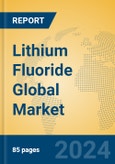Introduction
Lithium Fluoride (LiF) is a white crystalline compound used primarily in lithium-ion battery electrolytes, ceramics, and other applications like optical coatings. The lithium fluoride industry is characterized by its critical role in energy storage, driven by the global shift toward electric vehicles (EVs) and renewable energy. Key trends include the development of high-purity grades for advanced batteries, sustainable production processes, and capacity expansions to meet EV demand. The market is propelled by growth in lithium-ion battery production, particularly in Asia Pacific, and increasing use in ceramics for high-temperature applications. The industry faces challenges from raw material volatility and environmental regulations.Market Size and Growth Forecast
The global Lithium Fluoride market was valued at USD 530-920 million in 2024, with an estimated CAGR of 8.0%-10.0% from 2025 to 2030, driven by battery electrolyte applications.Regional Analysis
- North America is projected to grow at a CAGR of 7.8%-9.8%, with the U.S. leading due to its EV and battery manufacturing sectors, focusing on high-purity lithium fluoride.
- Europe is expected to achieve a CAGR of 7.5%-9.5%, with Germany driving demand through its EV and ceramics industries.
- Asia Pacific is anticipated to record the highest growth at 8.5%-10.5%, led by China, where battery production fuels demand, with trends toward localized supply chains.
- Rest of the World, particularly Brazil, is expected to grow at 7.3%-9.3%, supported by emerging EV markets.
Application Analysis
- Lithium-ion battery electrolyte applications are estimated to grow at a CAGR of 8.3%-10.3%, driven by lithium fluoride’s use in enhancing battery performance, with trends toward high-purity grades for fast-charging batteries.
- Ceramic applications are projected to expand at 7.8%-9.8%, supported by demand in high-temperature ceramics, with innovations in durable formulations.
- Other applications, including optical coatings, are expected to grow at 7.5%-9.5%, with advancements in precision optics.
Key Market Players
Stella Chemifa, headquartered in Osaka, Japan, produces lithium fluoride for battery electrolytes, known for its high-purity chemical solutions.Ganfeng Lithium Group, based in Xinyu, China, supplies lithium fluoride for batteries, focusing on integrated lithium operations.
Leverton, headquartered in Oxford, UK, provides lithium fluoride for ceramics, emphasizing sustainable production.
Sinomine, based in Beijing, China, offers lithium fluoride for battery applications, known for scalable manufacturing.
DFD, headquartered in Quzhou, China, supplies lithium fluoride for EVs, focusing on high-capacity production.
Guangzhou Tinci Materials Technology, based in Guangzhou, China, produces lithium fluoride for electrolytes, emphasizing advanced battery materials.
Porter’s Five Forces Analysis
- The threat of new entrants is low; high R&D costs and regulatory barriers create significant entry challenges.
- The threat of substitutes is moderate; alternative electrolyte materials compete, but lithium fluoride’s performance maintains its edge in batteries.
- Buyer power is moderate; battery manufacturers negotiate pricing, but high-purity grades limit their leverage.
- Supplier power is moderate; lithium raw material volatility creates some dependency.
- Competitive rivalry is high; players differentiate through purity levels and sustainable production.
Market Opportunities and Challenges
Opportunities
- Growth in EV and renewable energy markets drives lithium fluoride demand.
- Expansion of high-temperature ceramics enhances market opportunities.
- Emerging markets in Asia Pacific, particularly China, offer growth potential.
Challenges
- Volatility in lithium raw material prices impacts production costs.
- Environmental regulations on chemical production increase compliance costs.
- Competition from alternative electrolyte materials challenges market share.
Growth Trend Analysis
The Lithium Fluoride market is experiencing rapid growth, driven by its role in lithium-ion batteries. Sinomine operates with a 6,000-ton lithium fluoride capacity. On April 26, 2024, DFD acquired an 80% stake in Ningxia Tianlin, increasing its capacity from 12,000 tons to 18,000 tons. Guangzhou Tinci Materials Technology, with a 20,000-ton capacity, plans to invest over CNY 260 million to expand to 40,000 tons. These developments align with a projected CAGR of 8.0%-10.0% through 2030, reflecting lithium fluoride’s importance in EV batteries.This product will be delivered within 1-3 business days.
Table of Contents
Companies Mentioned
- Stella Chemifa
- Ganfeng Lithium Group
- Leverton
- Sinomine
- DFD
- Guangzhou Tinci Materials Technology








